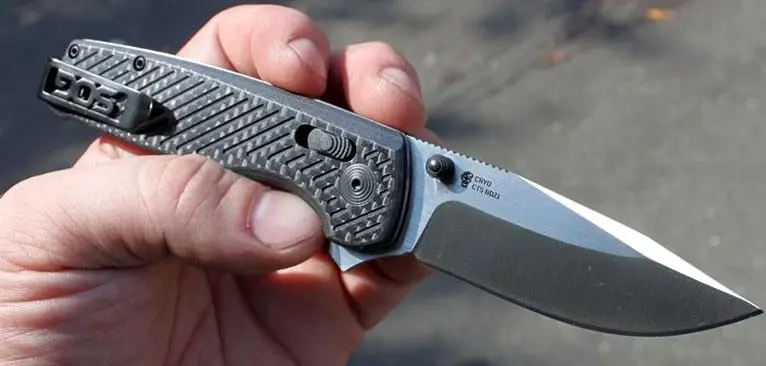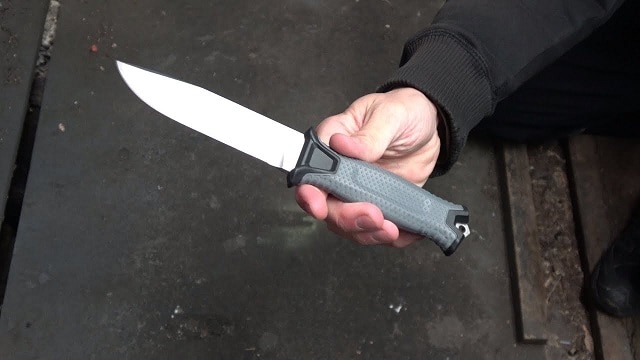(This site is reader-supported. When you buy something using retail links on our articles, we may earn a small commission. As an Amazon Associate I earn from qualifying purchases.)
In fact, those on a budget prefer CTS BDZ1 steel for their EDC and kitchen knives. It is low-mid entry steel considered ideal for EDC tools. Don’t be fooled by the Carpenter brand. Despite belonging to the CTS steel family, BDZ1 is not high premium steel. In this post, let’ find out whether this budget steel can be an ideal choice for you or not.
What is CTS BDZ1 Steel?
Also called BDZ1 or BDZ-1, this CTS steel is stainless steel chiefly used in making razor blades and knives. Made by the American brand Carpenter, it is specially formulated using a high amount of carbon and chromium as well as a distinct heat treatment facilitating a uniform distribution of chromium carbides. The resulting steel features a microstructure that can render a finer edge than other stainless steels.
This steel is used in making hand tools, razors, ice skates, salon and military blades, and different surgical or medical devices. It is also used to make different types of knives.
Just keep in mind that BDZ-1 is different from CTS BD1 or BD1N despite being from the same brand. CTS BD1N is a nitrogen-bearing modernistic option that provides superior hardness to CTS BDZ1.
Chemical Composition
BDZ1 is made up of a mix of carbon, manganese, and chromium in high amounts. Since the chromium content is greater than 13% it is stainless.
- 0.75% Carbon: For more hardness as well as a greater ability than usual to keep corrosion and wear at bay
- 13.5% Chromium: For excellent hardness, edge retention, toughness, resistance to corrosion and wear, and tensile strength
- 1% Manganese: For better forgeability, tensile strength, resistance to wear, and hardenability
- 1% Silicon: For better strength
- 0.75% Molybdenum: For better strength as well as machinability
- 0.025% Phosphorus: For better machinability, hardness, and strength
- 0.01% Sulfur: For better machinability and impact toughness
Being budget steel, BDZ-1 is close to AEB-L and 13C26 stainless steels in terms of price range and chemical composition.
Steel Hardness
On the Rockwell scale, CTS BDZ1 can attain a maximum hardness rating of 60 HRC. This is a moderate-high level of hardness, which only a few budget steels such as VG10 have. This hardness level is attributed to high carbon as well as chromium levels. The more chromium content enables the steel to retain its high hardness level even if heated at 200 degrees Celsius.
Steel Properties
- High Toughness: It is a fact that many hard steels deform when used frequently for tough tasks. This is because toughness decreases with the increasing level of hardness. However, this BDZ-1 is surprisingly tough due to the blend of carbon, chromium, manganese, and silicon elements, all of which are in high quantities.
- Decent Wear Resistance: As this steel is moderately hard, you can expect it to resist wear and tear for a long time. This makes this steel a highly durable option for your outdoor ventures. The credit goes to the mix of high manganese and high silicon contents apart from high carbon as well as chromium levels.
- Good Corrosion Resistance: As BDZ1 is stainless, you can expect it to keep rust and corrosion away.
- Okay Edge Retention: With a hardness rating of around 60 HRC, BDZ-1 steel ensures a decent retention of a sharp edge.
- Ease of Sharpening: The hardness level of BDZ1 is not that high enough to make sharpening difficult. In other words, it is easy to sharpen its edge with standard sharpening tools.
Comparison With Other Knife Steel Options
Let’s now compare the Carpenter steel with other steels in terms of different parameters such as toughness, hardness, sharpening ease, and corrosion and rust resistance.
BDZ1 vs 420HC
While carbon, molybdenum, and chromium ensure anti-corrosion power in BDZ1, the presence of nickel in 420HC makes it better at resisting rust. However, BDZ-1 is harder than 420HC.
BDZ1 vs D2
D2 is semi-stainless, while BDZ1 is stainless. The presence of finer carbides in the latter ensures even high toughness distribution, which is not there in D2. Although carbon is less, more chromium content than that in D2 makes the Carpenter steel better at resisting wear and corrosion.
BDZ1 vs S35VN
Both steels have similar abilities of rust and wear resistance. However, S35VN has vanadium instead of nickel and chromium. This makes it a bit harder than BDZ-1, hence it is better at resisting wear and maintaining a sharp edge for a long time. On the other hand, CTS steel is tougher than S35VN.
BDZ1 vs 14C28N
Both steels are resistant to wear and corrosion, but BDZ-1 is more resistant than 14C28N due to more chromium content. 14C28N is easier to sharpen and is less brittle.
BDZ1 vs S30V
While BDZ1 is made using a simple process, S30V is formulated using a complex technology called powder metallurgy. Still, both steels are the same in terms of toughness. S30V is high-tier premium steel, which means it is much costlier.
BDZ1 vs. VG10
Both steels rank the same in terms of sharpening ease. However, BDZ1 is far more resistant to stains than VG10 and is better in corrosion resistance and edge retention.
So, is CTS BDZ1 Steel Good?
Yes, if you are on a tight budget! CTS BDZ1 is a modern version of the classic 440A and is a decent steel for affordable knives.

Hi, I am Jay. I am the creator of Knife Guides, your one-stop site for everything related to knives. I am a computer engineer by profession, knife aficionado by passion. Here I work with a group of people who’ve always had a passion for knives and blades. Over the years we’ve kind of become experts and decided to share our knowledge and ideas. I am also an avid hiker and enjoy offshore gamefishing.


